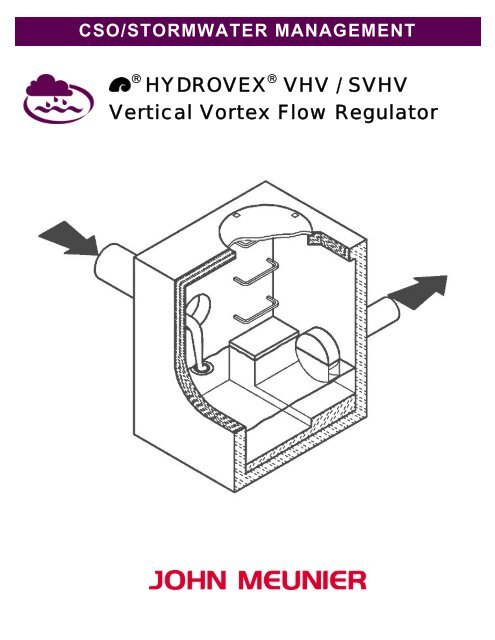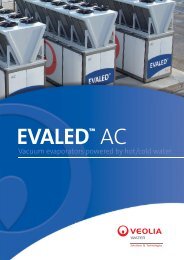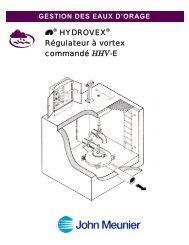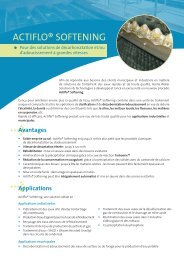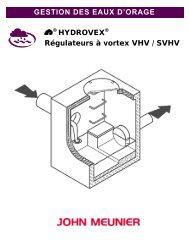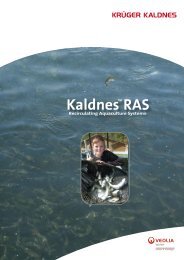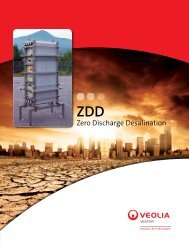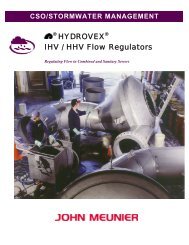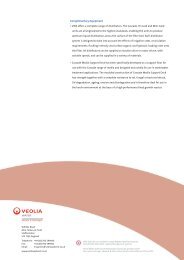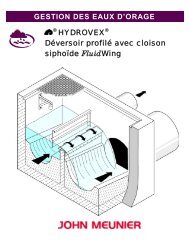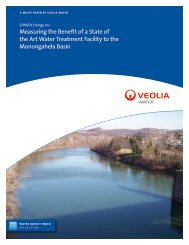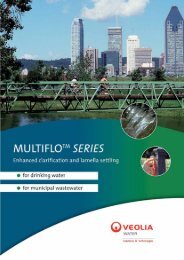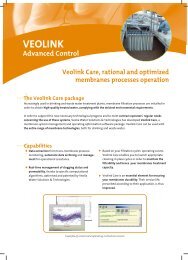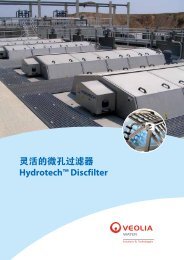® HYDROVEX® VHV / SVHV Vertical Vortex Flow Regulator
® HYDROVEX® VHV / SVHV Vertical Vortex Flow Regulator
® HYDROVEX® VHV / SVHV Vertical Vortex Flow Regulator
- No tags were found...
You also want an ePaper? Increase the reach of your titles
YUMPU automatically turns print PDFs into web optimized ePapers that Google loves.
CSO/STORMWATER MANAGEMENT<strong>®</strong>HYDROVEX <strong>®</strong> <strong>VHV</strong> / S<strong>VHV</strong><strong>Vertical</strong> <strong>Vortex</strong> <strong>Flow</strong> <strong>Regulator</strong>
HYDROVEX <strong>®</strong> <strong>VHV</strong> / S<strong>VHV</strong> VERTICAL VORTEX FLOW REGULATORINTRODUCTIONOne of the major problems of urban wet weather flow management is the runoff generated after a heavy rainfall. During a storm,uncontrolled flows may overload the drainage system and cause flooding. Due to increased velocities, sewer pipe wear is increaseddramatically and results in network deterioration. In a combined sewer system, the wastewater treatment plant may also experiencesignificant increases in flows during storms, thereby losing its treatment efficiency.A simple means of controlling excessive water runoff is by controlling excessive flows at their origin (manholes). John MeunierInc. manufactures the HYDROVEX <strong>®</strong> <strong>VHV</strong> / S<strong>VHV</strong> line of vortex flow regulators to control stormwater flows in sewer networks,as well as manholes.The vortex flow regulator design is based on the fluid mechanics principle of the forced vortex. This grants flow regulation withoutany moving parts, thus reducing maintenance. The operation of the regulator, depending on the upstream head and discharge,switches between orifice flow (gravity flow) and vortex flow. Although the concept is quite simple, over 12 years of research havebeen carried out in order to get a high performance.The HYDROVEX <strong>®</strong> <strong>VHV</strong> <strong>Vertical</strong> <strong>Vortex</strong> <strong>Flow</strong> <strong>Regulator</strong> (refer to Figure 1) is manufactured entirely of stainless steel, andconsists of a hollow body (1) (in which flow control takes place) and an outlet orifice (7). Two rubber "O" rings (3) seal and retainthe unit inside the outlet pipe. Two stainless steel retaining rings (4) are welded on the outlet sleeve to ensure that there is noshifting of the "O" rings during installation and use.1. BODY2. SLEEVE3. O-RING4. RETAINING RINGS(SQUARE BAR)5. ANCHOR PLATE6. INLET7. OUTLET ORIFICEHYDROVEX <strong>®</strong> <strong>VHV</strong> VERTICAL VORTREX FLOW REGULATORFIGURE 1 - <strong>VHV</strong>HYDROVEX <strong>®</strong> S<strong>VHV</strong> SPECIAL VERTICAL VORTEX FLOW REGULATORFIGURE 1 – S<strong>VHV</strong>1. BODY2. SLEEVE3. O-RING4. RETAINING RINGS(SQUARE BAR)5. ANCHOR PLATE6. INLET7. OUTLET ORIFICE
ADVANTAGES OF THE HYDROVEX <strong>®</strong> FLOW REGULATORS• The HYDROVEX <strong>®</strong> <strong>VHV</strong> / S<strong>VHV</strong> line of flow regulators is manufactured entirely of stainless steel,making them durable and corrosion resistant.• Having no moving parts, they require minimal maintenance.• The geometry of the HYDROVEX <strong>®</strong> <strong>VHV</strong> / S<strong>VHV</strong> flow regulators allows a control equal to an orificeplate, having a cross section area 4 to 6 times smaller. This decreases the chance of blockage of theregulator, due to sediments and debris found in stormwater flows.• Installation of the HYDROVEX <strong>®</strong> <strong>VHV</strong> / S<strong>VHV</strong> flow regulators is quick and straightforward and isperformed after all civil works are completed.• Installation requires no special tools or equipment and may be carried out by any contractor.• Installation may be carried out in existing structures.HYDROVEX SELECTION CRITERIA <strong>VHV</strong> OR S<strong>VHV</strong>Figure 2 is a graphical representation of the head vs. discharge range for various <strong>VHV</strong> or S<strong>VHV</strong> regulators. This curve is afunction of the maximum upstream static water pressure (head) and the discharge. As may be seen from the two curves, the S<strong>VHV</strong>models have larger cross-sectional flow areas than the <strong>VHV</strong>'s for a given discharge and head.Model selection is performed by determining the maximum design flow at the manhole outlet and the maximum design head at theinsert of the manhole outlet pipe. Each regulator is applicable for operation within a range of head and discharge values, asillustrated by the graph. Using this information one can refer to Figure 2 and determine which model is applicable. All selectionsshould be verified by John Meunier Inc. personnel prior to fabricationFIGURE 3:DISCHARGE CURVE FOR A HYDROVEX <strong>®</strong> 100 S<strong>VHV</strong>-1-100AND A 4" Ø ORIFICE PLATE
<strong>VHV</strong> <strong>Vertical</strong> <strong>Vortex</strong> <strong>Flow</strong> <strong>Regulator</strong>FIGURE 2 - <strong>VHV</strong>
S<strong>VHV</strong> <strong>Vertical</strong> <strong>Vortex</strong> <strong>Flow</strong> <strong>Regulator</strong>FIGURE 2 - S<strong>VHV</strong>
DIMENSIONING OF MANHOLESMost HYDROVEX <strong>®</strong> models may be installed in a standard 36 inch diameter manhole. All models may also be installed in arectangular manhole with a minimum dimension of 36 inches (24 inch diameter or rectangular manhole may be used for smallermodels).NOTE that in the case of a square manhole, the outlet flow pipe must be centered on the wall to ensure enough clearance for theunit. A minimum clearance "H" should be established between the floor of the manhole and the invert of the outlet pipe to install theregulator. Figure 4 gives the various dimensions required for a given regulator.HOW TO SPECIFY THE TYPE OF HYDROVEX <strong>®</strong> REGULATORIn order to specify a HYDROVEX <strong>®</strong> regulator, the following parameters must be defined:• The model number (ex: 100-<strong>VHV</strong>-1)• The diameter and type of outlet pipe (ex: 6" diam. SDR 35 or 8" diam. RCP)• The desired discharge (ex: 50 l/s or 1.76 CFS)• The upstream head (ex: 2 m or 6.56 ft.) *• The manhole diameter (ex: 36" diam.)• The minimum clearance "H" (ex: 10 inches)• The material type (ex: 304 s/s, 11 Ga. standard)PLEASE NOTE THAT WHEN REQUESTING A PROPOSAL, WE SIMPLY REQUIRE THAT YOU PROVIDE US WITHTHE FOLLOWING:‣ project design flow rate‣ pressure head‣ chamber’s outlet pipe diameterNOTE:Upstream head is defined as the difference in elevation between the maximum upstream water level and theinvert of the outlet pipe where the HYDROVEX <strong>®</strong> flow regulator is to be installed.Typical <strong>VHV</strong> in factory<strong>VHV</strong> with air vent for minimal slopes
FLOW REGULATOR TYPICAL INSTALLATION IN CIRCULAR MANHOLEFIGURE 4 ( MODEL <strong>VHV</strong> )ModelNumber<strong>Regulator</strong>DiameterManholeDiameterMinimumOutlet PipeMinimumClearanceA (mm) A (in.) B (mm) B (in.) C (mm) C (in.) H (mm) H (in.)50<strong>VHV</strong>-1 203 8 600 24 150 6 127 575<strong>VHV</strong>-1 280 11 600 24 150 6 152 6100<strong>VHV</strong>-1 356 14 900 36 150 6 203 8125<strong>VHV</strong>-2 330 13 900 36 200 8 203 8150<strong>VHV</strong>-2 406 16 900 36 200 8 229 9200<strong>VHV</strong>-2 533 21 1200 48 254 10 305 12250<strong>VHV</strong>-2 660 26 1200 48 300 12 356 14300<strong>VHV</strong>-2 787 31 1600 64 375 15 406 16350<strong>VHV</strong>-2 914 36 1800 72 375 15 508 20Minimum clearance “H” relates to the diameter indicated in the chart.If the outlet diameter decreases, the “H” clearance will also decrease.
ModelNumberFLOW REGULATOR TYPICAL INSTALLATION IN CIRCULAR MANHOLEFIGURE 4 ( MODEL S<strong>VHV</strong> )<strong>Regulator</strong>DiameterManholeDiameterMinimumOutlet PipeMinimumClearanceA (mm) A (in.) B (mm) B (in.) C (mm) C (in.) H (mm) H (in.)25 S<strong>VHV</strong>-1 152 6 600 24 150 6 152 632 S<strong>VHV</strong>-1 178 7 600 24 150 6 152 640 S<strong>VHV</strong>-1 229 9 600 24 150 6 152 650 S<strong>VHV</strong>-1 279 11 600 24 150 6 152 675 S<strong>VHV</strong>-1 432 17 900 36 150 6 279 11100 S<strong>VHV</strong>-2 356 14 900 36 200 8 254 10125 S<strong>VHV</strong>-2 432 17 900 36 200 8 305 12150 S<strong>VHV</strong>-2 559 22 1200 48 250 10 356 14200 S<strong>VHV</strong>-2 686 27 1600 64 300 12 457 18250 S<strong>VHV</strong>-2 864 34 1800 72 375 15 559 22300 S<strong>VHV</strong>-2 1041 41 2400 96 375 15 660 26350 S<strong>VHV</strong>-2 1194 47 2400 96 375 15 711 28Minimum clearance “H” relates to the diameter indicated in the chart. If the outletdiameter decreases, the “H” clearance will also decrease
ModelNumberFLOW REGULATOR TYPICAL INSTALLATION IN SQUARE MANHOLEFIGURE 4 ( MODEL S<strong>VHV</strong> )<strong>Regulator</strong>DiameterManholeDiameterMinimumOutlet PipeMinimumClearanceA (mm) A (in.) B (mm) B (in.) C (mm) C (in.) H (mm) H (in.)25 S<strong>VHV</strong>-1 152 6 600 24 150 6 152 632 S<strong>VHV</strong>-1 178 7 600 24 150 6 229 640 S<strong>VHV</strong>-1 229 9 600 24 150 6 229 650 S<strong>VHV</strong>-1 279 11 600 24 150 6 152 675 S<strong>VHV</strong>-1 432 17 600 24 150 6 229 11100 S<strong>VHV</strong>-2 356 14 600 24 200 8 178 10125 S<strong>VHV</strong>-2 432 17 600 24 200 8 229 12150 S<strong>VHV</strong>-2 559 22 600 24 250 10 254 14200 S<strong>VHV</strong>-2 686 27 900 36 300 12 330 18250 S<strong>VHV</strong>-2 864 34 900 36 375 15 406 22300 S<strong>VHV</strong>-2 1041 41 1200 48 375 15 508 26350 S<strong>VHV</strong>-2 1194 47 1200 48 375 15 610 28Minimum clearance “H” relates to the diameter indicated in the chart.If the outlet diameter decreases, the “H” clearance will also decrease.
FV – S<strong>VHV</strong> (mounted onsliding plate)<strong>VHV</strong>-1-O (typical model withodour control inlet)FV - <strong>VHV</strong> (mounted on sliding platewith odour control inlet)<strong>VHV</strong> with Gooseneck assembly in existing chamber withoutminimum release at the bottomTypical chamber for <strong>VHV</strong>-S<strong>VHV</strong> with Gooseneck
Typical roof drain chamber<strong>VHV</strong> used as roof drain in building’s pipingINSTALLATIONThe installation of a HYDROVEX <strong>®</strong> regulator may be undertaken once the manhole and piping is in place. Installation consists ofsimply fitting the regulator into the outlet pipe of the manhole. John Meunier Inc. recommends the use of a lubricant on the outletpipe, in order to facilitate the insertion and orientation of the flow controller.MAINTENANCEHYDROVEX <strong>®</strong> regulators are manufactured in such a way as to be maintenance free; however, a periodic inspection (every 3-6months) is suggested in order to ensure that neither the inlet nor the outlet has become blocked with debris. The manhole shouldundergo periodically, particularly after major storms, inspection and cleaning as established by the municipalityGUARANTEEThe HYDROVEX <strong>®</strong> line of regulators are guaranteed against both design and manufacturing defects for a period of 5 years. Should aunit be defective, John Meunier Inc. is solely responsible for either modification or replacement of the unit, at their discretion.John Meunier Inc.ISO 9001 : 2000Head Office4105 SartelonSaint-Laurent (Quebec) Canada H4S 2B3Tel.: 514-334-7230 www.johnmeunier.comFax: 514-334-5070 cso@johnmeunier.comOntario Office2000 Argentia Road, Plaza 4, Unit 430Mississauga (Ontario) Canada L5N 1W1Tel.: 905-286-4846 www.johnmeunier.comFax: 905-286-0488 ontario@johnmeunier.comUSA Office2209 Menlo AvenueGlenside, PA USA 19038Tel.: 412- 417-6614 www.johnmeunier.comFax: 215-885-4741 asteele@johnmeunier.comRevised : 2008-10-01


